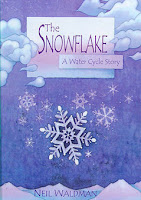In the last week we've had a snow day and an early dismissal for snow. It's only been a few inches, but it has been most welcomed by the kids around me. In anticipation of and celebration of snow, we've been reading a few of our favorite books on the subject.
The Story of Snow: The Science of Winter's Wonder, written by Mark Cassino with Jon Nelson - Mark Cassino is a fine art and natural history photographer. Jon Nelson is a teacher and physicist who studies ice crystals and clouds. Together they have given us a stunning volume on the formation of snow. A perfect mixture of art and science, Cassino's photographs are accompanied by clearly written text that explains a very complex process in terms kids will understand. Readers will learn what snow is made from, how it forms, what shapes it takes, and more! Photos of snow crystals are included with a comparison of the enlarged images to a snow crystal of actual size.
In the back matter you will find directions on how to catch snow crystals and examine them. For more ideas for extending the text, download a teacher's guide for this title at the Chronicle web site.
Snowflake Bentley, written by Jacqueline Briggs Martin and illustrated by Mary Azarian - This Caldecott Medal winner tells the true story of Wilson Bentley, a farmer who spent the better part of his life studying and photographing snowflakes. It begins this way.
In the days
when farmers worked with ox and sled
and cut the dark with lantern light,
there lived a boy who loved the snow
more than anything else in the world.
Willie's story is told from his childhood through his death. Accompanying the biography are a series of sidebars that contain additional facts about Bentley. The last page of the book contains a photo of Bentley at his camera (the same one at the top of the Wilson Snowflake Bentley home page), a quote about his love for photography, and three of his renowned snowflake images.
This is the story of a remarkable man who pushed the limits of science and technology to create groundbreaking images of snowflakes. If the book inspires an interest in further study, you can view a number of his amazing photographs at The Bentley Snow Crystal Collection.
The Secret Life of a Snowflake: An Up Close Look at the Art and Science of Snowflakes, written by Kenneth Libbrecht - The author of this book is a physicist at Caltech known for his passion for snow crystals. In this book aimed at 9-12 year olds, but appropriate for a much broader (and older) audience, Libbrecht teaches readers what snow crystals and snowflakes are, where they come from, and how these amazing structures are created out of thin air. His own photographs beautifully complement the text.
All snowflakes begin with water vapor in air, but as they begin their journey toward the ground, changes in temperature and humidity determine their exact and unique shape. Libbrecht answers questions that many children (and adults) are apt to ask, such as "Why is snow white when the crystals that comprise snow are clear?"
Libbrecht's web site, SnowCyrstals.com, provides a wealth of images and even more information for those readers who finish the book and want to learn more. I recommend starting with the Snowflake Primer and the Snow Crystal FAQs.
The Snowflake: A Water Cycle Story, written by Neil Waldman - While ostensibly not a book about snowflakes, this water cycle book does begin and end with a snowflake. I like this book because it makes understandable the idea that resources on Earth are finite. Kids have a hard time with this notion, but Waldman makes this message clear as readers learn that the water we drink, wash in, and play in is part of an amazing cycle that repeats itself over and over and over again.
Water takes many different forms, but it's the form of snow in which this journey begins. In January a snowflake lands on the peak of a mountain. Over the course of year the snowflake changes both location and form. In February it's blown into a mountain pond, where it melts in March. This tiny droplet sinks into an underground stream where it continues its journey. That water drop travels to a farm and evaporates into the clouds before it comes back down to the ground to travel even further. Eventually it becomes a snowflake once more.
This post was written for Nonfiction Monday. The round up is being hosted by Laura Salas. Do stop by and check out all the wonderful books being shared today.




I love Snowflake Bentley! I found out you can order an affordable paperback collection of many of his snowflake photos on Amazon. Thanks for sharing his book and these other snow books. It snowed 6 inches here last night, so I'm definitely in the right mood for your post. :)
ReplyDeleteperfect books for today - it's snowing outside. Huge flat quarter-sized flakes!
ReplyDeleteWe've been experiencing snow here too. A mixed bag for sure! My 7 yo was just asking me if I had ever heard of Snowflake Bentley. :) Guess they had that one at school! Thanks for these recommendations!
ReplyDeletePerfect post for today, as we got several fresh inches of snow yesterday in Minneapolis, and the world is white and wonderful again! I love SNOWFLAKE BENTLEY, and I esp want to check out THE SECRET LIFE...Thanks, Tricia!
ReplyDeleteThe rain just washed away our snow - but I'm sure we'll get more. Thanks for sharing these books. Renee
ReplyDelete